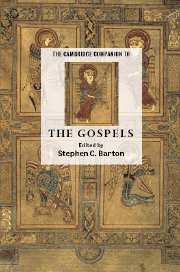Book contents
- Frontmatter
- Introduction
- Part I Approaching the gospels: context and method
- 1 What is a gospel?
- 2 The fourfold gospel
- 3 The canonical matrix of the gospels
- 4 The gospels and ‘the historical Jesus’
- 5 The gospels and the reader
- Part II The gospels as witnesses to Christ: content and interpretation
- Part III The afterlife of the gospels: impact on church and society
3 - The canonical matrix of the gospels
from Part I - Approaching the gospels: context and method
Published online by Cambridge University Press: 28 January 2007
- Frontmatter
- Introduction
- Part I Approaching the gospels: context and method
- 1 What is a gospel?
- 2 The fourfold gospel
- 3 The canonical matrix of the gospels
- 4 The gospels and ‘the historical Jesus’
- 5 The gospels and the reader
- Part II The gospels as witnesses to Christ: content and interpretation
- Part III The afterlife of the gospels: impact on church and society
Summary
Jesus and his first followers were Jews whose symbolic world was shaped by Israel's scripture: their categories for interpreting the world and their hopes for God's saving action were fundamentally conditioned by the biblical stories of God's dealings with the people Israel. Therefore, it is not surprising that as the earliest Christian communities began to tell and retell stories about Jesus, they interpreted his life, death and resurrection in relation to those biblical stories (i.e., the texts that Christians later came to call the Old Testament). The authors of our four canonical gospels were the heirs of this tradition of storytelling, and they shared the early Christian community's passionate concern - a concern that, as far as we can tell, goes back to Jesus himself - to show that Jesus' teachings and actions, as well as his violent death and ultimate vindication, constituted the continuation and climax of the ancient biblical story. Thus, all four canonical gospels developed within the matrix of Israel's scripture: the Old Testament was the generative milieu for the gospels, the original environment in which the first Christian traditions were conceived, formed and nurtured. Because each of the four gospels - different as they are - narrates the story of Jesus as the continuation and fulfillment of Israel's story, the earliest accounts of Jesus must be understood within their original scriptural environment. The point may be illustrated by comparing the parable of the wicked tenants in its canonical versions (Mk 12.1-12/Matt 21.33-46/Lk 20.9-19) to the stripped-down version that appears in the extracanonical second-century Gospel of Thomas (GosT 65).
- Type
- Chapter
- Information
- The Cambridge Companion to the Gospels , pp. 53 - 75Publisher: Cambridge University PressPrint publication year: 2006
- 1
- Cited by



